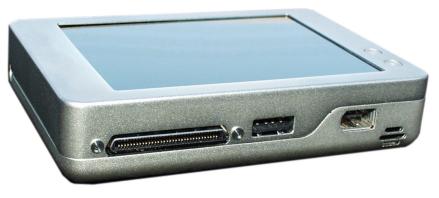New ‘ultra-personal computer’ will run Linux (and much more)
Apr 17, 2002 — by LinuxDevices Staff — from the LinuxDevices Archive — 1 viewsOQO (pronounced “oh-q-oh”) unveiled a unique tiny modular computer at Microsoft's WinHEC conference today in Seattle, WA. The newly created “ultra-personal computer” PC category has the potential to “transform personal computing the same way the cell phone has revolutionized telecommunications,” says OQO executive vice president Colin Hunter.
OQO's new device weighs just 9 ounces, is small enough (4.9 x 2.9 x 0.9 in.) to fit in your shirt pocket, yet contains the processing and storage resources of a well equipped desktop PC. In fact, it is designed to instantly transform itself into just such a system by popping it into a cradle which adds connections to a full-sized keyboard and monitor, along with a standard Ethernet network interface. Wireless interfaces for both IEEE 802.11 and Bluetooth are built directly into the device.

According to Hunter, the market opportunity for the ultra-personal computer is significant. “PC sales today are estimated to be 150 million units per year,” says Hunter. “Out of that total, mobiles comprise roughly 27 million units and are growing at a double-digit rate, while desktops are in decline.”
“With the advent of cheap 802.11 wireless, the trend towards mobility is likely to pick up speed,” Hunter adds. “The OQO ultra-personal computer is nicely positioned as a product that enhances the mobile wireless PC experience while being substantially more functional than any PDA or multimedia device. The OQO device should [therefore] attract users from both sides of the product spectrum.”
Hunter says the new OQO device has a built-in 10 gigabyte hard drive, which has “enough space to store [the operating system plus] over 1000 MP3 songs [or] 3 movies in MPEG4 format.”
The OQO device's screen, though small, is said to provide sufficient resolution to be equivalent, when held in a hand at a typical distance of 8-20 inches from the user's eye, to a notebook's 12-14 inch LCD that rests on a desk at a distance of 1-2 feet from the user.
The device will come with a “basic cradle”, which will allow users to plug in a standard keyboard and monitor, and which will also provide Ethernet and USB expansion ports, plus power for operating the system and recharging its batteries. The basic cradle will have a place for the user to add a DVD drive. Another option will be a case, shaped roughly like a notebook computer, which accepts the OQO device and which adds a notebook-style LCD display and keyboard, DVD drive, larger batteries, and in general provides “a full laptop experience,” says Hunter.
And that's not all. LinuxDevices.com learned from an undisclosed source that OQO is also developing a low-powered FM radio transmitter that will allow users of the device to wirelessly broadcast music from MP3s stored on its hard disk to their home or car stereos.
What about Linux support for the device? “We're primarily a hardware company,” says Hunter. “What we've developed is a fully compatible PC, that will run whatever OS would run on a PC, so yeah, Linux should run just fine — I'm sure it'll happen,” he adds.
Summary of specs
- Processor: 1 GHz Transmeta Crusoe TM5800
- RAM memory: 256 MB (not expandable)
- Internal hard disk: 1.8-inch 10+ GB
- Display:
- 4-inch diagonal TFT color LCD
- 640 x 480 pixels resolution
- LED backlight (developed by OQO to be thinner and lower power than the one that normally is included with the display)
- 4-inch diagonal TFT color LCD
- Touch input: A specially designed sSynaptics capacitive touchscreen
- Keyboard options:
- On-screen “soft” keyboard
- Hardware keyboard (“slideup tray”)
- On-screen “soft” keyboard
- Input/output interfaces:
- Built-in 802.11b and Bluetooth radios and antennas
- USB 1.1
- Audio out connector
- Built-in microphone
- Built-in 802.11b and Bluetooth radios and antennas
- “OQO-link” expansion connector — for connection to docking stations and external “dongles”; includes signals for:
- 2 Firewire interfaces
- 2 USB ports
- Serialized PCI bus
- Video
- Audio
- Power
- 2 Firewire interfaces
- Mechanical:
- Size: 4.9 x 2.9 x 0.9 in.
- Weight: 9 oz
- Size: 4.9 x 2.9 x 0.9 in.
- Batteries:
- Advanced lithium polymer technology
- Typical computing use: 8 hrs
- MPEG movie watching: 2 hrs
- MP3 music playing: 7 hrs
- Standby mode: greater than 1 week
- Advanced lithium polymer technology
According to Hunter, the OQO device will be priced “at the low end of the notebook range”. How much is that? “Around $1,000 to $1,200,” he says.
When can I get one? “It will be in volume production by the end of 2002,” adds Hunter.
More about OQO
OQO was created by Jory Bell and Joe Betts-Lacroix, along with other members of the team that developed the Apple Titanium. OQO, Inc. was founded in 1999 and is located in San Francisco. The company includes executives, engineers, and designers who have held key positions at Apple Computer, Caltech Jet Propulsion Lab, IBM Almaden Research, MIT, Oracle, and Transmeta. Colin Hunter was the cofounder of Hunter and Ready Systems (cofounded with MontaVista Software founder Jim Ready) and later cofounded Transmeta Corp.
This article was originally published on LinuxDevices.com and has been donated to the open source community by QuinStreet Inc. Please visit LinuxToday.com for up-to-date news and articles about Linux and open source.